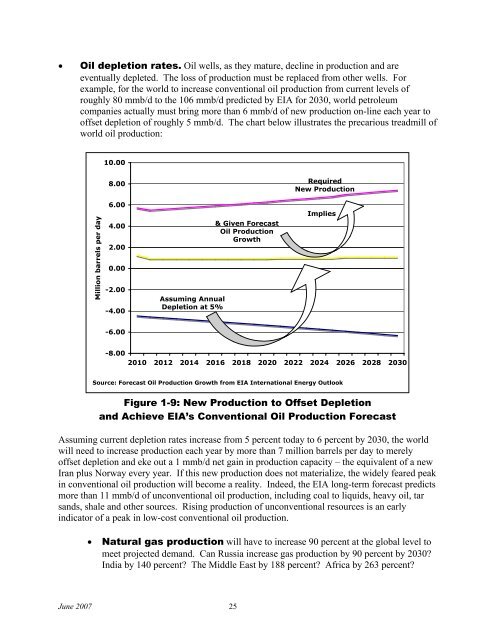Technologies to Reduce or Capture and Store Carbon Dioxide Emissions
TECHNOLOgIEs to Reduce or Capture and store Carbon Dioxide ...
TECHNOLOgIEs to Reduce or Capture and store Carbon Dioxide ...
You also want an ePaper? Increase the reach of your titles
YUMPU automatically turns print PDFs into web optimized ePapers that Google loves.
• Oil depletion rates. Oil wells, as they mature, decline in production <strong>and</strong> are<br />
eventually depleted. The loss of production must be replaced from other wells. F<strong>or</strong><br />
example, f<strong>or</strong> the w<strong>or</strong>ld <strong>to</strong> increase conventional oil production from current levels of<br />
roughly 80 mmb/d <strong>to</strong> the 106 mmb/d predicted by EIA f<strong>or</strong> 2030, w<strong>or</strong>ld petroleum<br />
companies actually must bring m<strong>or</strong>e than 6 mmb/d of new production on-line each year <strong>to</strong><br />
offset depletion of roughly 5 mmb/d. The chart below illustrates the precarious treadmill of<br />
w<strong>or</strong>ld oil production:<br />
10.00<br />
Million barrels per day<br />
8.00<br />
6.00<br />
4.00<br />
2.00<br />
0.00<br />
-2.00<br />
-4.00<br />
Assuming Annual<br />
Depletion at 5%<br />
& Given F<strong>or</strong>ecast<br />
Oil Production<br />
Growth<br />
Required<br />
New Production<br />
Implies<br />
-6.00<br />
-8.00<br />
2010 2012 2014 2016 2018 2020 2022 2024 2026 2028 2030<br />
Source: F<strong>or</strong>ecast Oil Production Growth from EIA International Energy Outlook<br />
Figure 1-9: New Production <strong>to</strong> Offset Depletion<br />
<strong>and</strong> Achieve EIA’s Conventional Oil Production F<strong>or</strong>ecast<br />
Assuming current depletion rates increase from 5 percent <strong>to</strong>day <strong>to</strong> 6 percent by 2030, the w<strong>or</strong>ld<br />
will need <strong>to</strong> increase production each year by m<strong>or</strong>e than 7 million barrels per day <strong>to</strong> merely<br />
offset depletion <strong>and</strong> eke out a 1 mmb/d net gain in production capacity – the equivalent of a new<br />
Iran plus N<strong>or</strong>way every year. If this new production does not materialize, the widely feared peak<br />
in conventional oil production will become a reality. Indeed, the EIA long-term f<strong>or</strong>ecast predicts<br />
m<strong>or</strong>e than 11 mmb/d of unconventional oil production, including coal <strong>to</strong> liquids, heavy oil, tar<br />
s<strong>and</strong>s, shale <strong>and</strong> other sources. Rising production of unconventional resources is an early<br />
indica<strong>to</strong>r of a peak in low-cost conventional oil production.<br />
• Natural gas production will have <strong>to</strong> increase 90 percent at the global level <strong>to</strong><br />
meet projected dem<strong>and</strong>. Can Russia increase gas production by 90 percent by 2030?<br />
India by 140 percent? The Middle East by 188 percent? Africa by 263 percent?<br />
June 2007 25


